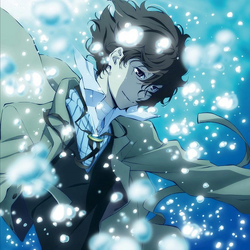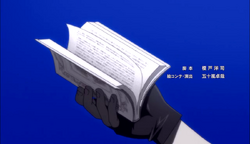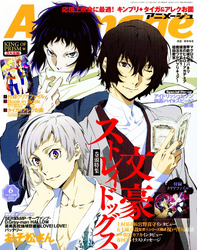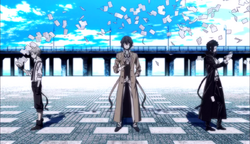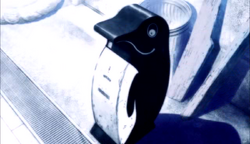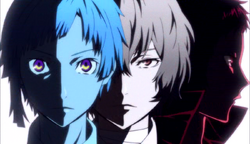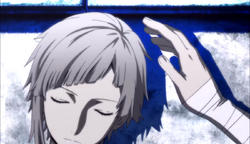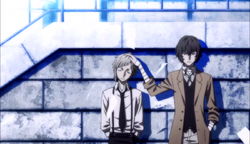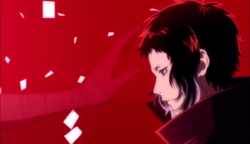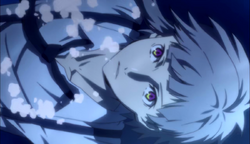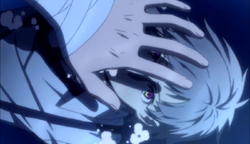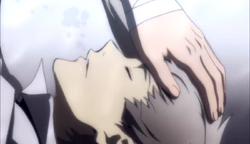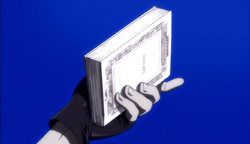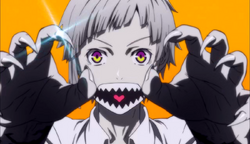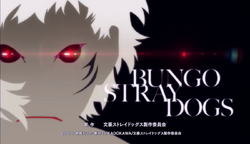- Source: PASH! PLUS+ August 2016 Issue
We go straight to the questions with Bungo Stray Dogs‘ voice actor Kisho Taniyama in this special interview excerpt from the PASH! August Issue.
-I definitely want to continue playing the role of Chuya Nakahara until the part where Chuya battles with the Fellowship of the Guild member, Lovecraft. I get to fight along with Mamochan (voice actor Mamoru Miyano), and I’ve been excited for that specific part ever since I read the original manga series. I’m really excited to see how they decide to portray those battle scenes in this anime series. I think everyone should look forward to it with great anticipation. You get to go deeper into the love/hate relationship between Chuya and Dazai, and their past really come into play in their complicated relationship. I’ve always loved reading H.P. Lovecraft’s novels and the horror themes always made it so thrilling.
2. H.P. Lovecraft is actually an author and poet in right life, and has written many horror novels and created the fictional god known as ‘Cthulhu.’
-I love horror novels, and I used to read about Cthulhu. I do remember that it was a very difficult reading, and there were times where I’d read the lines, but I wouldn’t be paying attention. But since growing up, I’ve gone back and read these books again, and I feel like I can appreciate them on a different level, now that I’m older myself. It’s exciting to hear that so many people are watching the anime series, but I also hope that by watching the series, it will also spark an interest for others to read the original manga. By knowing about the original author, it will allow the viewer to get a bigger and better look into a completely different world.
3. Would you say the experience is one the things that makes this series so appealing?
-Absolutely! If you don’t know anything about the novel or the author, I definitely want to recommend people to give it a try and go on this crazy adventure. The story shows a number of characters who go through various changes and in a way, they’re going through their own stages of something similar to puberty. I personally love being in that kind of world, because I have my personal issues that I dealt with and can relate.
Masaaki Iizuka and I sing ‘Trash Candy’ with our band ‘Granrodeo’ for the opening theme song, and we’ve incorporated the theme of going through stages of change in this song. A while back, we came out with the song ‘Sugar’ and there’s a line in the song that says, ‘First part, Chuya Nakahara-sama’ and when I first got the role of Chuya Nakahara, a fan came up to me and told me that I was lucky to get a role that I loved so much. To be honest it was all a coincidence, but I’m so thrilled to be a part of this exciting project.
4. When you started to prepare for your role of voicing Chuya Nakahara, did you do any research to learn about your character?
-The role that I play is a character as well as an actual author, so I wanted to at least have a general idea of who he was as a person. As I learned more about him, I realized that there were certain similarities between us. His poetry is known for being very abstract, and the songs that I write tend to be abstract as well. We both have baby faces, he also was into alcohol, and he also didn’t get along with Dazai Osamu, lol. Knowing small details about him has helped me get an idea of how I wanted to portray him as a character.
- Source: Animage magazine June 2016/Vol. 456
Yasuomi Umetsu, the animator, director, and screenwriter well known with oversea fans, has been famous for directing numerous (TV anime) opening and endings sequences. This time, he has handled storyboard, direction, and animation direction for the ending sequence for "Bungo Stray Dogs".
"I wanted to express what Dazai and Akutagawa are meant to Atsushi at a deeper level.", said Umetsu. Thus he made the sequence featuring the relationship among Atsushi, Dazai, and Akutagawa as a basis.
With triangular relationship looping around Akutagawa to Dazai; Atsushi to Dazai; Dazai to Akutagawa, he made the sequence by visualizing their relationship portrayed in the first cour of the show. From details of their perspective to hand gestures, there is intricate drama weaved in them. We want to present how scenes in this beautiful "Bungo Stray Dogs" ending sequence leaves a deep impression on us by Umetsu's abundant imagination.
Interview #1: Yasuomi Umetsu
(Direction, Storyboard, Animation Direction)
--What kind of impression did you get after reading the manga?
Umetsu: At first glance by the title alone, I wondered if this was like "I Vitelloni" (1953 Italian film directed by Federico Fellini) with novelists as the main subject. When I read it, it has an exceptionally strong impression of the battle genre, but I felt a triangular relationship among Atsushi, Dazai, and Akutagawa.
---So there are only three characters that appear in the ending sequence.
Umetsu: When I make opening and ending, I always consult with the director, producer, and video makers first, but this time I received an order from Director Takuya Igarashi to feature these three characters. With those characters on hand, I thought I could bring out other characters as I was handling the storyboard, but I realized it's better to focus on those three main characters as I was processing the visual concept.
---Did you and Director Igarashi had a more specific discussion?
Umetsu: More like listening to his thought on the works than a specific order. It is necessary to find commonality between his thought and my thought, but this time we had the same impression. I brought my draft with the expectation of "perhaps mine is like this" to Igarashi and he felt that "this direction is fine" and so there was no hesitation. Except physical work took so much time and I barely made to the last minute (bitter smile)
---What kind of impression did you have for (ending) theme song, "I'll call out a name/Namae wo Yobuyo"?
Umetsu: It's really a great song! My quite often make a decision by the tune of the song. If melody, tempo, rhythm, and etc don't coordinate, then overall doesn't synchronize well with visuals. On the contrary, if a song is good, it blends well with the worldview and it widens overall imagery. Because I especially liked this song, the work went smoothly. When I read Luck Life's lyrics, I had the impression that their goal and my direction weren't so different.
--Luck Life (Artists for the ending theme song) said they expanded their imagery from Atsushi's line of "you can't go on living without telling someone that 'it's good to be alive'".
Umetsu: Absolutely! That's the heart of the matter. It seems like Atsushi and others are living off from such feelings.
---Do you jump onto storyboard right after expanding your ideas?
Umetsu: No, I draw concept sketches at least once before drawing storyboard. It's like drawing dozens of sketches and pick from there. This time I drew around 40 sketches, I think? I think there are some people who jump right into storyboarding, but for me it's no good for not having concept images side-by-side. On top of that, I'm the type who thinks about (small) things like "how should I set up cut #1..."
---From the start you're making it while not thinking about continuity, but just putting them all together.
Umetsu: That's right. I build it with a list of images first and once I lay them out, the whole thing would tell the story in a mysterious way!
---Which cut was the first thing that came into your mind?
Umetsu: Image of Atsushi sinking in water came into my mind first. Actually, I was inspired by a scene from a movie. It's like I kept it alive in my heart for 15 years so that I could use it someday.
---This time, you were able to pull it off after the long-wait.
Umetsu: As I love films, yet I can't remember which film it was! (laughs). In addition, cover illustrations for both Opening CD and Ending CD are featuring Atsushi and Dazai sinking into the water and that was a total coincidence. I was really surprised by them.
---It seems like you went to Yokohama for inspiration
Umetsu: I felt something was lacking as I was drawing the storyboard. So I hurriedly went to Yokohama for reference. My concept idea has gotten broader as I took photos of the actual locale. When I thought about 'how to move things to where", there is still a limit to just sitting behind the desk and working on the storyboard. I reaffirmed the importance of the overall atmosphere through the actual visit (to the locale). As for the first scene where each character is holding a book and I thought, "I want to position them here" after seeing the actual Yokohama's scenery.
---What is the most rewarding part of you for making the opening and ending sequence?
Umetsu: It's not about copying from original manga material to video form as it is; it's about adding atmosphere and weight into it. Since the opening sequence is the face of the show so I can't venture off too far, but because I think the ending sequence has a slightly loose grip (on creative aspect), I threw in some curveballs from time to time (laughs). With this ending sequence, it was really fun putting together (animation) staff's design and my concept. Now that my thoughts on this title are condensed into a video form, I hope that people would enjoy this ending and the show repeatedly.
Scene-by-scene Commentary
1. Works of Literary Figures
Atsushi holding (his own) book. Text of the actual novel is pasted on pages: "Sangetsuki" by Atsushi Nakajima; "No Longer Human" by Osamu Dazai; "Rashomon" by Ryunosuke Akutagawa. "I had other ideas by attaching staff credit on the pages, but I used this way to make a connection with the story" (Umetsu). In addition, the cover illustration of the (Animage) magazine features the same book.
2. Flying Pages
Pages are flying off to the sky one by one. "This book is Atsushi's heart and body". The pages are a part of (his) life. As those pages fly, they mingle with Dazai's and Akutagawa's and affecting one another" (Umetsu). Although Atsushi appears mainly passive by people around him in the beginning, in reality, he affects people around him like flying pages.
3. Atsushi and Dazai lying down
The background is modeled from a dock in Yokohama. Dazai is lying next Atsushi, but their hands still don't touch. "Atsushi's pinky finger is moving just a little because it's the most heart-pounding moment whether it is going touch or not" (Umetsu). It's definitely a delicate balance between their relationship.
4. Contrasting shots of moon-lit night
Atsushi lost in thought by window and Akutagawa walking on a night street. Each goes on with one's fate with a full moon set as background. "On color selection discussion with Igarashi, I've set Atsushi's theme color as bluish-white, Dazai's as white, and Akutagawa's as red for the motif. To bring out those three colors, I've set aside the usual background and cel color scheme. And those three colors came out forward much more" (Umetsu).
5. Objects and Mental Imagery
A sudden flash of four images in a subliminal way. These elephant and penguin objects are all actually in Yokohama. According to Umetsu, he "brought out the city's atmosphere first then depicted characters' mental scenery". Objects and Atsushi and Dazai are flashed in alternate sequence. On two cuts where Atsushi's shirt is off and blood is spilling from Dazai's mouth, Umetsu added as "a prediction of cruel future which is likely to happen".
6. Atsushi's shadow turns into tiger's shape
The shadow on the wall slowly becomes the tiger's shape. Reason for drawing it as a shadow? "Because the epitome of transformation scene has to be shown in the episode, so there is no reason to draw it in the ending. Even though opening and ending are not about depicting specific story elements, it's important to express the symbolic matters of the show"(Umetsu). Such is his persistence.
7. Pages that stopped moving
Pages of the book on the ground are flipped by blowing wind, but they stopped when the wind stopped. And then, text in pages disappear and become meaningless. "Those are Atsushi's heart, body, and a part of his life" (Umetsu). What sort of meaning is hidden in the disappearing text?
8. Atsushi/Dazai and Akutagawa
Atsushi and Dazai, while Akutagawa who is farther apart from them (top picture). Atsushi and Dazai are facing front while Akutagawa is facing other directions (bottom picture). These three characters' relationship is expressed frankly by these two shots. As for the reason why the above cuts are in red and white, "I wanted show comparison between Dazai and Akutagawa. By putting Atsushi with Dazai, it brought out a strong feeling of Atsushi and Dazai as a pair." Umetsu explains.
9. Dazai petting Atsushi's head
Dazai reaches out and gently pets Atsushi who is lost in thought. And Atsushi smiles faintly. "Tweaking that smile was very difficult" as Umetsu points out. As time flows peacefully, what will become of Atsushi and Dazai? Even flying pages don't have an answer for that.
10. Dazai doesn't reach out to Akutagawa
Akutagawa looks down with sadness in front of the red brick warehouse. His shadow turns into white and Dazai's hand reaches out, but his hand fades away. "Probably to Akutagawa, Dazai's existence is like nothing like anything else. I definitely think only Dazai can save Akutagawa" (Umetsu). However, when is that salvation? Thus Dazai's hand fades out like an illusion.
11. Sinking Atsushi
Atsushi drops into a sea. Also, Yokohama scenery is shown in the background. "Atsushi has both naivety and a part of irrationality mixed together. Instead of changing, he still doesn't know how to deal with himself" Umetsu said. That is why his facial expression wants to say something while sinking. "It's his unique face expression mixed with various thoughts" Umetsu added.
12. Dazai's hand in water
Again Dazai's hand touches Atsushi's head. Reason for doing it the second time: "It's like Atsushi will stumble and fall many times in his life. However, Dazai will reach out again and again" Umetsu explains. It's Dazai's expression of 'even if you fail and being forsaken, you keep true to yourself'. Then Atsushi's surrounding turns into Dazai's theme color of white.
13. Akutagawa shedding red tear
Akutagawa sinks and his bloody tear floats out from the water and flies off like a firework. It represents his sadness and rage and Umetsu himself loves that cut. Also, the sea is analyzed as "a sea formed by many shed tears". Even though Dazai's hand reaches to sinking Atsushi, he doesn't reach out to sinking Atakugawa.
14. At a special place by himself
The above cuts are also modeled from Yokohama. Akutagawa is kneeling under the shade and Atsushi stands momentarily at a place under the morning sun. Pages of another book scatter around Akutagawa's coat.
15. Closed Book
The book is in Atsushi's hand again, but the book is closed. Flying pages are nowhere to go. This cut is drawn as "an image which no one knows where those pages will lead in the future" (Umetsu).
16. Stylization of the last part with pop art
The sudden appearance of two fascinating cuts: "I didn't want to end with cut and dry feeling; so I wanted something to save the thought of 'let's watch it next week too'". On half-weretiger cut: "As a character, Atsushi can goof off too, right? It's too complicated for Dazai and Akutagawa though (laughs)" as Umetsu comments on the cut which Atsushi shows "roar" expression with heart-shaped windpipe. On the final cut's graphic style image, Umetsu concluded," I wanted to close the ending in style with (Atsushi's) just-right-before-turning-into-tiger image."
References[]
[]
| Collaboration Archive · Interview Archive · Model Sheet Archive · News Archive · Sketch Archive · Translation Archive | |


